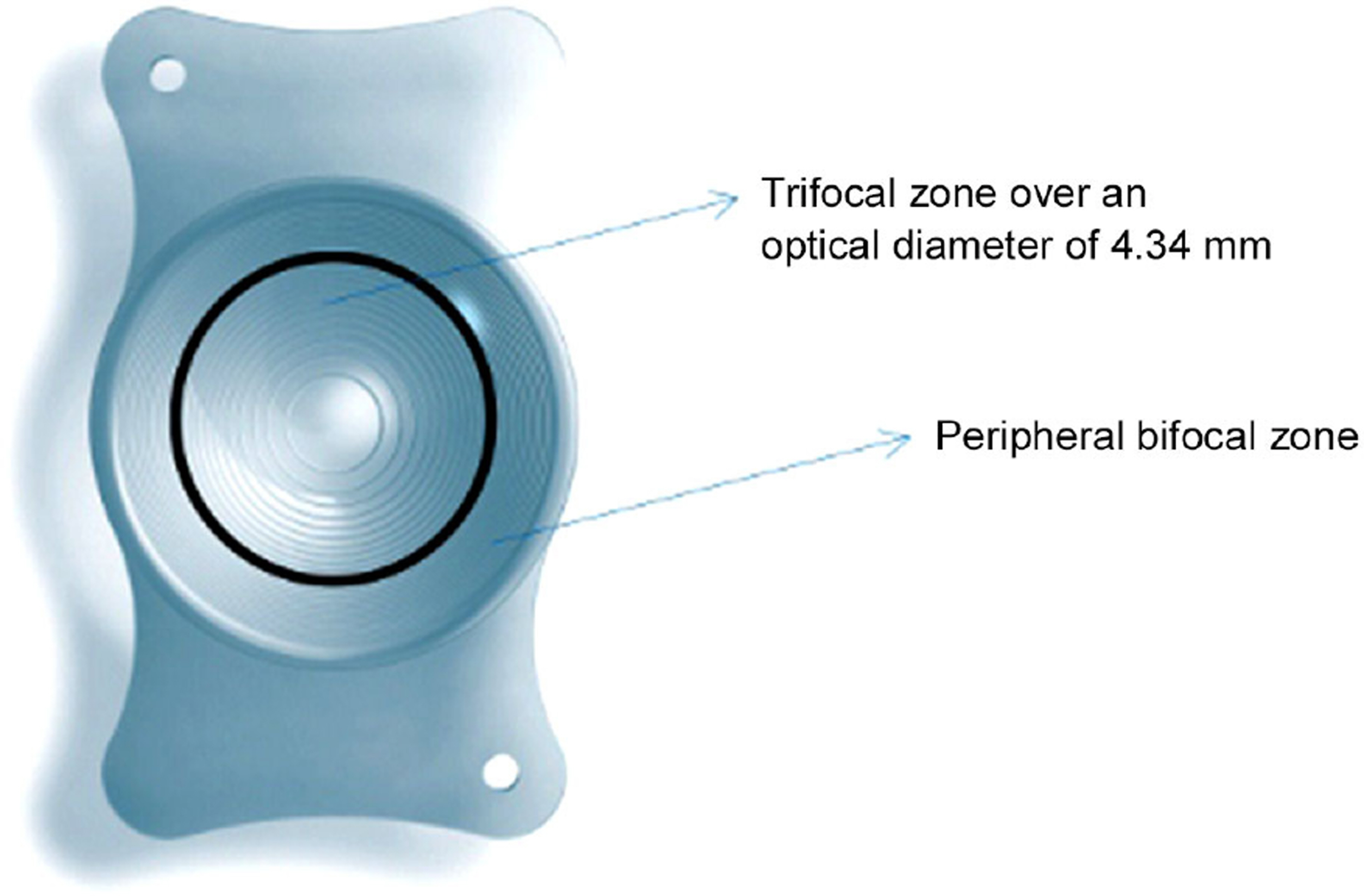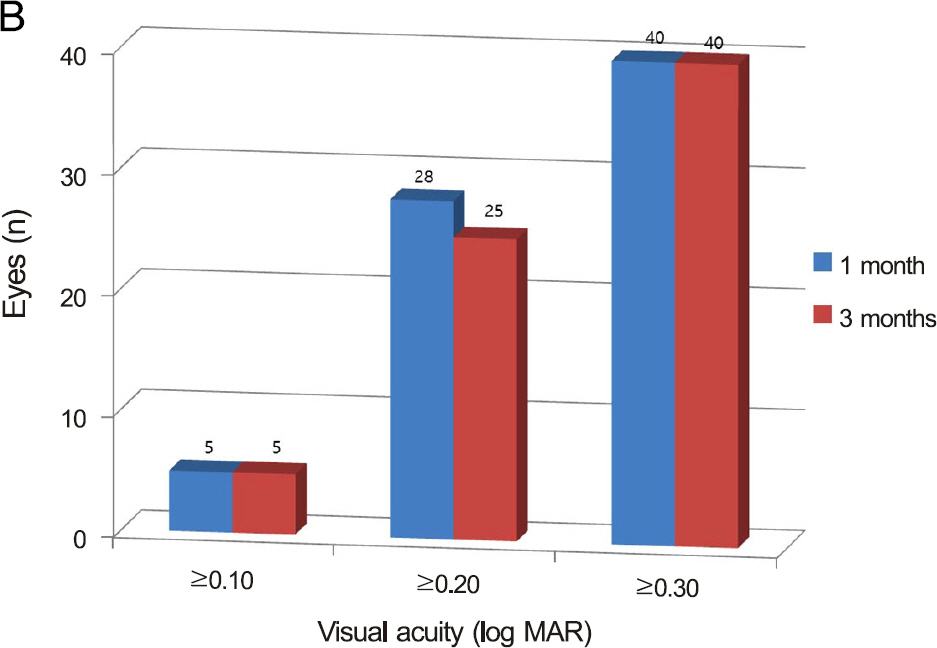J Korean Ophthalmol Soc.
2015 Sep;56(9):1338-1344. 10.3341/jkos.2015.56.9.1338.
Clinical Outcomes of Diffractive Aspheric Trifocal Intraocular Lens Implantation
- Affiliations
-
- 1HanGil Eye Hospital, Incheon, Korea. chobjn@empal.com
- KMID: 2214547
- DOI: http://doi.org/10.3341/jkos.2015.56.9.1338
Abstract
- PURPOSE
To evaluate the clinical outcomes of patients with diffractive aspheric trifocal intraocular lens (AT.LISA tri839 MP(R) IOL, Carl Zeiss Meditec, Jena, Germany) implantation.
METHODS
Forty eyes of 53 patients received phacoemulsification and implantation of AT.LISA tri839 MP(R) IOL (Carl Zeiss Meditec). Uncorrected distant visual acuity (UDVA), uncorrected intermediate visual acuity (UIVA), uncorrected near visual acuity (UNVA), refractive values, and defocus curve were evaluated at postoperative 1 month and 3 months. Optical quality was evaluated with the Optical Quality Analysis System (OQAS(R), Visiometrics, Castelldefels, Spain).
RESULTS
At the 3-month postoperative follow-up, the mean spherical equivalent was 0.01 +/- 0.31 D and the mean UDVA, UIVA and UNVA were 0.023 +/- 0.020, 0.155 +/- 0.091, and 0.139 +/- 0.069, respectively. The means of the objective scatter index, modulation transfer function cut-off value, Strehl ratio measured by OQAS(R) (Visiometrics) were 1.83 +/- 0.52, 33.58 +/- 14.27 cycle per degree and 0.18 +/- 0.11, respectively. Intermediate visual acuity did not fall sharply at defocus curve.
CONCLUSIONS
Implantation of the diffractive aspheric trifocal intraocular lens in patients with cataracts provided excellent distant, intermediate and near visual acuities with high visual quality.
MeSH Terms
Figure
Cited by 2 articles
-
Clinical Outcomes of Diffractive Aspheric Trifocal Intraocular Lens Implantation
Jung Hyun Lee, Young Joo Cho, Tae Hyung Lim, Kee Yong Choi, Beom Jin Cho
J Korean Ophthalmol Soc. 2018;59(2):145-152. doi: 10.3341/jkos.2018.59.2.145.Comparison of Reading Speed after Bilateral Bifocal and Trifocal Intraocular Lens Implantation
Moses Kim, Jae-hyung Kim, Tae-Hyung Lim, Beom Jin Cho
Korean J Ophthalmol. 2018;32(2):77-82. doi: 10.3341/kjo.2017.0057.
Reference
-
References
1. Kim JH, Yu S, Koo SH. . Clinical outcomes of diffractive mul-tifocal toric intraocular lens implantation. J Korean Ophthalmol Soc. 2014; 55:1139–49.
Article2. Kim SM, Kim CH, Chung ES, Chung TY. Visual outcome and pa-tient satisfaction after implantation of multifocal IOLs: three-month follow-up results. J Korean Ophthalmol Soc. 2012; 53:230–7.
Article3. Kohnen T, Allen D, Boureau C. . European multicenter study of the AcrySof ReSTOR apodized diffractive intraocular lens. Ophthalmology. 2006; 113:584.e1.
Article4. Petermeier K, Messias A, Gekeler F. . Outcomes of the Acrysof ReSTOR IOL in myopes, emmetropes, and hyperopes. J Refract Surg. 2009; 25:1103–9.
Article5. Petermeier K, Szurman P. Subjective and objective outcome fol-lowing implantation of the apodized diffractive AcrySof ReSTOR. Ophthalmologe. 2007; 104:399–404. 406-8.6. Law EM, Aggarwal RK, Kasaby H. Clinical outcomes with a new trifocal intraocular lens. Eur J Ophthalmol. 2014; 24:501–8.
Article7. Mojzis P, Peña-García P, Liehneova I. . Outcomes of a new dif-fractive trifocal intraocular lens. J Cataract Refract Surg. 2014; 40:60–9.
Article8. Kim YJ, Cheon MH, Ko DA. . Visual function and patient sat-isfaction in pseudophakic monovision. J Korean Ophthalmol Soc. 2012; 53:1621–9.
Article9. Lee HY, Her J. Clinical evaluation of monovision after cataract surgery. J Korean Ophthalmol Soc. 2008; 49:1437–42.
Article10. Kwon JW, Kang S, Chung SK, Baek NH. Clinical results of Crystalens(R) (AT-45) accommodating intraocular lens. J Korean Ophthalmol Soc. 2009; 50:1179–83.11. Lee HS, Park SH, Kim MS. Clinical results and some problems of multifocal apodized diffractive intraocular lens implantation. J Korean Ophthalmol Soc. 2008; 49:1235–41.
Article12. Cumming JS, Slade SG, Chayet A. . Clinical evaluation of the model AT-45 silicone accommodating intraocular lens: results of feasibility and the initial phase of a Food and Drug Administration clinical trial. Ophthalmology. 2001; 108:2005–9.
Article13. Nakazawa M, Ohtsuki K. Apparent accommodation in pseudo-phakic eyes after implantation of posterior chamber intraocular lenses. Am J Ophthalmol. 1983; 96:435–8.
Article14. Trindade F, Oliveira A, Frasson M. Benefit of against-the-rule as-tigmatism to uncorrected near acuity. J Cataract Refract Surg. 1997; 23:82–5.
Article15. Park CW, Lee YE, Joo CK. Changes in optical quality of cataract patients' corrected visual acuity before and after phacoemulsification. J Korean Ophthalmol Soc. 2013; 54:1208–12.
Article16. Saad A, Saab M, Gatinel D. Repeatability of measurements with a double-pass system. J Cataract Refract Surg. 2010; 36:28–33.
Article
- Full Text Links
- Actions
-
Cited
- CITED
-
- Close
- Share
- Similar articles
-
- Comparison of the Visual Outcomes after Cataract Surgery with Implantation of a Bifocal and Trifocal Diffractive Intraocular Lens
- Trifocal versus Bifocal Diffractive Intraocular Lens Implantation after Cataract Surgery or Refractive Lens Exchange: a Meta-analysis
- Clinical Outcomes of Diffractive Aspheric Trifocal Intraocular Lens Implantation
- Clinical Outcomes of Diffractive Trifocal Intraocular Lens in Both Eyes: A 6-Month Follow-Up
- Effects of Bifocal versus Trifocal Diffractive Intraocular Lens Implantation on Visual Quality after Cataract Surgery




